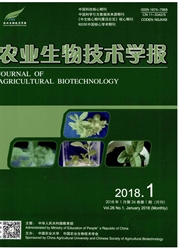

 中文摘要:
中文摘要:
采用绵羊(Bos gaurus)体细胞带下注入体外成熟的卵母细胞构建重构胚,比较了不同的融合和化学激活前培养时间对重构胚融合和发育的影响。融合前培养1h,比较不同的激活前培养时间,发现各组重构胚卵裂率、桑椹胚率和囊胚率均无显著差异(P〉0.05),但激活前培养2h胚胎完整率(95.81%)高于对照(74.64%),差异显著(P〈0.05);激活前培养2h,比较不同的融合前培养时间,发现两组融合率,激活胚胎完整率和囊胚率无显著差异(P〉0.05),但融合前培养1h的卵裂率(76.88%)和桑椹胚率(40.63%)显著高于直接融合(64.48%和21.50%)(P〈0.05)。利用G1和G2培养早期克隆胚胎,将发育至桑椹胚囊胚的胚胎移植到41只受体绵羊,仅1只妊娠但于第104天流产。用5对绵羊微卫星DNA多态性引物对该克隆流产胎儿皮肤成纤维细胞、供体细胞、受体绵羊及一只普通对照母绵羊皮肤成纤维细胞进行微卫星DNA分析,结果表明5对微卫星DNA引物扩增各组细胞DNA,扩增产物经过10%琼脂糖凝胶电泳和银染后,条带均有明显的多态性。条带分析显示,克隆流产胎儿的微卫星DNA指纹与供体细胞完全相同,而不同于其受体母亲和对照绵羊。证明该流产羔羊基因来源于供体细胞,为体细胞克隆绵羊。
 英文摘要:
英文摘要:
In order to compare the effects of culturing time before electrical fusion and chemical activation on the fusion and development of the constructed embryo, embryos were reconstructed by subzonal injecting the sheep (Bos gaurus) somatic cells into matured sheep oocytes in vitro. Results showed that culturing for 1 h before electrical fusion, there were no significant differences in cleavage, morulas and blastulas rates among the groups(P 〉0.05), however, the integrity rate of couplets cultured for 2 h before activation (95.81%) was significantly higher than control (74.64%)(P 〈 0.05); under the condition of culturing for 2 h before chemical activation, there were no remarkable differences in the rate of fusion, integrity and the blastulas (P 〉0.05), but the rate of cleavage and morula which were cultured for lh before activation (76.88% and 40.63%) were dramatically higher than control(64.48%and 21.50%) (P 〈0.05). When developed into morula or blastulas in commercial G1/G2 sequential medium, the embryos were transferred into 41 recipients, only one finally was developed into a fetus but aborted when it was 104 day old in vivo. Then microsatellites DNA analysis with 5 pairs of primers was carried out on the fibroblast of aborted fetus, donor cells, the fibroblast of recipient sheep and one control chosen occasionally. Results indicated that the bands had polymorphism after 10%Ago-Gel clectrophoresis of PCR products and silver staining, and the fingerprint of cloned fetus were completely the same as those of donor cells, while definitely different from those of recipient sheep and the control, and the gene of cloned fetus came from donor cells and the fetus was a cloned sheep.
 同期刊论文项目
同期刊论文项目
 同项目期刊论文
同项目期刊论文
 Establishing a human pancreatic stem cell line and transplanting induced pancreatic islets to revers
Establishing a human pancreatic stem cell line and transplanting induced pancreatic islets to revers Derivation and characterization of human embryonic germ cells: serum-free culture and differentiatio
Derivation and characterization of human embryonic germ cells: serum-free culture and differentiatio 期刊信息
期刊信息
